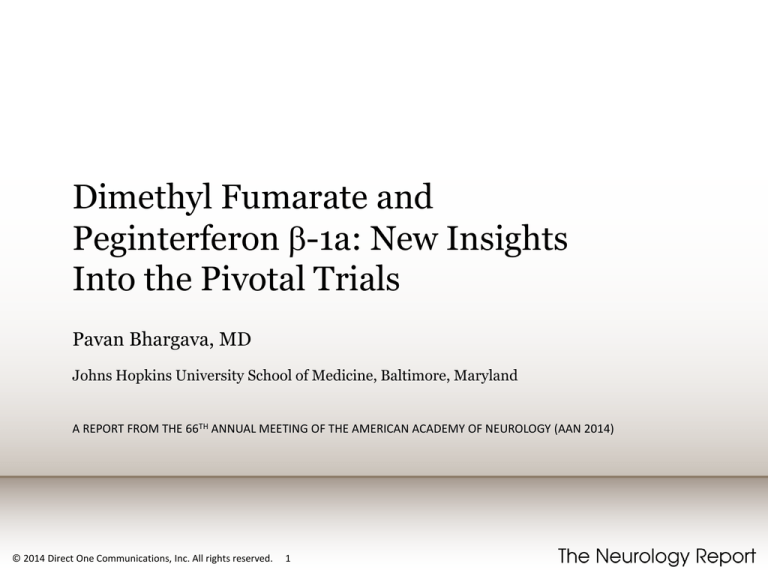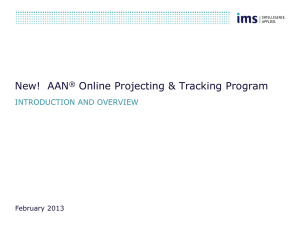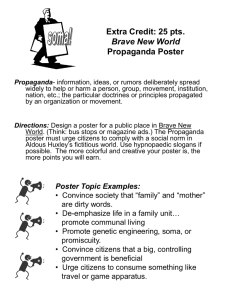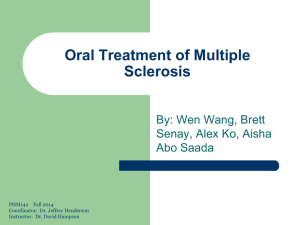
Dimethyl Fumarate and
Peginterferon b-1a: New Insights
Into the Pivotal Trials
Pavan Bhargava, MD
Johns Hopkins University School of Medicine, Baltimore, Maryland
A REPORT FROM THE 66TH ANNUAL MEETING OF THE AMERICAN ACADEMY OF NEUROLOGY (AAN 2014)
© 2014 Direct One Communications, Inc. All rights reserved.
1
Introduction
The armamentarium of medications approved by the
US Food and Drug Administration (FDA) to treat
patients with multiple sclerosis (MS) continues to
expand.
Treatment decisions must balance the efficacy of a
disease-modifying therapy with its adverse effects.
Other factors, such as impact on quality-of-life
measures, are also becoming an important part of
this decision, since they may play a role in
determining the real-world effectiveness of a
medication.
© 2014 Direct One Communications, Inc. All rights reserved.
2
Dimethyl Fumarate
© 2014 Direct One Communications, Inc. All rights reserved.
3
Pharmacology
Dimethyl fumarate is an oral second-generation
fumarate ester that was approved by the FDA for the
treatment of relapsing-remitting MS in 2013.
Dimethyl fumarate appears to exert its effects
primarily through the nuclear factor (erythroidderived 2)-like 2 (Nrf2) pathway, which is involved
in cellular defense against oxidative stress and also
in immune homeostasis.
The efficacy of dimethyl fumarate was demonstrated
in two pivotal phase 3 randomized, controlled
clinical trials—DEFINE and CONFIRM.
Gold R et al. N Engl J Med. 2012;367:1098; Fox RJ et al. N Engl J Med. 2012;367:1087
© 2014 Direct One Communications, Inc. All rights reserved.
4
Inclusion and Exclusion Criteria
Major inclusion and
exclusion criteria in
the DEFINE and
CONFIRM studies
Gold R et al. N Engl J Med. 2012;367:1098; Fox RJ et al. N Engl J Med. 2012;367:1087
© 2014 Direct One Communications, Inc. All rights reserved.
5
Efficacy in Highly Active Disease
In all, 136 RRMS patients with highly active disease
(two or more relapses in the year prior to study plus
one or more gadolinium-enhancing MRI lesions at
baseline) were identified in DEFINE and CONFIRM.
Dimethyl fumarate twice daily reduced the
annualized relapse rate (ARR) by 60.3% (P =
0.0018) versus placebo.
Dimethyl fumarate twice daily also reduced the risk
of relapse (HR = 0.368; P = 0.003) versus placebo.
These data show that dimethyl fumarate twice daily
is effective in MS patients with highly active disease.
Hutchinson M et al. AAN 2014, Poster P3.189
© 2014 Direct One Communications, Inc. All rights reserved.
6
Efficacy in Highly Active Disease
Annualized relapse rate in RRMS patients
with highly active disease
Hutchinson M et al. AAN 2014, Poster P3.189
© 2014 Direct One Communications, Inc. All rights reserved.
7
Efficacy in Minority Populations
A total of 29 patients of African, 54 of Hispanic, and
136 of Asian decent were identified in the DEFINE
and CONFIRM populations.
Patients on dimethyl fumarate twice daily in all three
minority subgroups showed a reduction in ARR and
in the proportion of patients who relapsed at 2 years.
Similar trends were noted in disability progression.
The small sample size, however, limits definite
conclusions.
Hutchinson M et al. AAN 2014, Poster P3.171
© 2014 Direct One Communications, Inc. All rights reserved.
8
Health-Related Quality of Life (HRQoL)
In all, 464 patients were analyzed, of which 136 were
on placebo, 128 on dimethyl fumate (DMF) bid, 135
on DMF tid, and 65 on glatiramer acetate (GA).
Physical component scores on the SF-36 improved
significantly in patients taking DMF bid or tid
compared with those on GA or placebo.
Mental component scores on the SF-36 improved
significantly in the DMF bid group but not in the
other treatment groups.
EQ-5D scores also improved in patients taking DMF
bid or tid compared with those on GA or placebo.
Kita M et al. AAN 2014, Poster P4.176
© 2014 Direct One Communications, Inc. All rights reserved.
9
Measures of HRQoL
Description of patient-reported outcome measures
Kita M et al. AAN 2014, Poster P4.176
© 2014 Direct One Communications, Inc. All rights reserved.
10
HRQoL: Effect of Previous Treatment
Effects on HRQoL measures were analyzed based on
treatment (none, interferon or GA, other treatment)
prior to entry into DEFINE and CONFIRM.
In the treatment-naïve subgroup, a significantly
greater proportion of patients on DMF bid or tid
showed either no change or improvement, compared
with placebo, in the SF-36 physical scores but not
mental scores.
In the prior interferon/GA treatment group, a
significant proportion of patients on DMF bid or tid
showed no change or improvement, compared with
placebo, in the SF-36 physical and mental scores.
Kappos L et al. AAN 2014, Poster P3.162
© 2014 Direct One Communications, Inc. All rights reserved.
11
Freedom from Disease Activity
A larger proportion of patients taking DMF bid (69%)
or tid (71%) had no measurable clinical disease activity
at 2 years than those on placebo (53%; P = 0.0001).
Similarly, a larger proportion of patients on DMF bid
(34%) or tid (35%) at 2 years showed no measurable
neuroradiologic disease activity on MRI than those on
placebo (20%; P = 0.0001).
The proportion of patients with no measurable overall
disease activity at 2 years was larger in the DMF bid
(23%) and tid (23%) groups than in the placebo group
(11%; P = 0.0001).
Havrdova E et al. AAN 2014, Poster P3.159
© 2014 Direct One Communications, Inc. All rights reserved.
12
ENDORSE Study: Clinical Efficacy
ENDORSE is a 5-year extension study of the
DEFINE and CONFIRM trials designd to evaluate
the long-term safety and efficacy of DMF.
Among the patients continuing on DMF bid, the ARR
was 0.142 after 2 years of treatment and 0.198 after
4 years of treatment, suggesting continued clinical
efficacy of DMF.
Among the patients switching from placebo or
glatiramer acetate to DMF bid or tid, the ARR at the
end of 2 years of treatment with DMF was similar to
that noted at the end of 2 years of DMF treatment in
the DEFINE and CONFIRM studies.
Gold R et al. AAN 2014, Poster P3.173
© 2014 Direct One Communications, Inc. All rights reserved.
13
ENDORSE Study: Clinical Efficacy
Changes in annualized relapse rate
Hutchinson M et al. AAN 2014, Poster P3.189
© 2014 Direct One Communications, Inc. All rights reserved.
14
ENDORSE Study: MRI Outcomes
The MRI cohort in the DEFINE and CONFIRM
studies consisted of 1,221 patients with RRMS, of
whom 718 went on to the ENDORSE study.
Among patients who continued on DMF bid, 68%
were free of new/enlarging T2 lesions, 76% were free
of new T1 hypointense lesions, and 88% were free of
gadolinium-enhancing lesions at year 2 in the
ENDORSE study.
At year 2 in the ENDORSE study, patients who had
switched from placebo or glatiramer acetate to DMF
seemed to have similar MRI activity to that seen in
the parent DEFINE and CONFIRM studies.
Arnold D et al. AAN 2014, Poster P3.160
© 2014 Direct One Communications, Inc. All rights reserved.
15
ENDORSE Study: MRI Outcomes
Number of new and/or enlarging T2 lesions
Hutchinson M et al. AAN 2014, Poster P3.189
© 2014 Direct One Communications, Inc. All rights reserved.
16
Conclusions
Dimethyl fumarate is an important oral diseasemodifying therapy option for the treatment of MS.
Evidence suggests continued clinical and radiological
efficacy, in addition to a benefit in terms of HRQoL,
beyond the original DEFINE and CONFIRM trial
periods.
Further data from the ENDORSE study will help
elucidate the long-term efficacy and safety of this
medication.
© 2014 Direct One Communications, Inc. All rights reserved.
17
Peginterferon b-1a
© 2014 Direct One Communications, Inc. All rights reserved.
18
Pharmacology and Clinical Efficacy
Peginterferon b-1a is a modified form of interferon
b-1a that has a polyethylene glycol (PEG) group
attached to interferon b-1a.
The attachment of PEG to interferon b-1a prolongs
its half-life, reducing the frequency of dosing.
The ADVANCE trial was a phase 3 study comparing
placebo to subcutaneous peginterferon b-1a 125 µg
every 2 or 4 weeks for 1 year.
Patients taking peginterferon b-1a every 2 or 4 weeks
showed a reduction in ARR, disability progression,
and MRI measures of disease activity compared with
those on placebo at 48 weeks.
Calabresi PA et al. Lancet Neurol. 2014;13:657
© 2014 Direct One Communications, Inc. All rights reserved.
19
Pharmacology and Clinical Efficacy
Design of the ADVANCE study
Calabresi PA et al. Lancet Neurol. 2014;13:657
© 2014 Direct One Communications, Inc. All rights reserved.
20
Pharmacokinetics and Pharmacodynamics
Maximum serum level of peginterferon b-1a was
reached at 1.0–1.5 days after injection, and the
terminal half-life was 2–5 days for both the every-2week and every-4-week regimens.
By doubling the frequency of dosing, the every-2week regimen provided twice the exposure to
peginterferon b-1a than the every-4-week regimen.
Anti-PEG antibodies had no effect on the pharmacokinetics of peginterferon b-1a.
Neopterin levels (marker of IFN receptor activation)
reached a peak elevation at 3 days post peginterferon
b-1a injection and remained elevated for 10–14 days.
Hu X et al. AAN 2014, Poster P3.194
© 2014 Direct One Communications, Inc. All rights reserved.
21
Pharmacokinetics and Pharmacodynamics
Serum peginterferon b-1a and neopterin levels
Hu X et al. AAN 2014, Poster P3.194
© 2014 Direct One Communications, Inc. All rights reserved.
22
Effect on Relapse-Associated Costs
The cost of multiple sclerosis per year in the US is
estimated to range from $44,000 to $88,000 per
patient in 2006 dollars.
Treatment with peginterferon b-1a every 2 weeks for
1 year reduced the cost of hospitalization by $1,297
(95% CI: 288, 2,173), the cost of IV corticosteroids by
$62 (95% CI: 20, 99), and the cost of MS relapse by
$1,941 (95% CI: 877, 2,931) compared with placebo.
Every-2-week administration of peginterferon b-1a
had a high probability of reducing relapse-related
costs as compared with every-4-week dosing.
Kobelt G et al. Neurology. 2006;66:1696; O’Day K et al. AAN 2014, Poster P4.146
© 2014 Direct One Communications, Inc. All rights reserved.
23
Impact on HRQoL
As compared with placebo, disability progression
was associated with a lower worsening in MSIS-29
physical scores in patients taking peginterferon b-1a
every 2 weeks.
Similarly, the worsening of MSIS-29 psychological
scores associated with a relapse in the placebo group
was greatly attenuated in the group receiving
peginterferon b-1a every 2 weeks.
These results suggest that peginterferon b-1a every 2
weeks not only reduces the occurrence of relapse and
disability progression but also reduces the impact of
these events on HRQoL.
Kinter E et al. AAN 2014, Poster P4.177
© 2014 Direct One Communications, Inc. All rights reserved.
24
Conclusions
Results from the pivotal ADVANCE study help
establish the efficacy and safety of peginterferon b-1a
given every 2 weeks.
Pegylated interferon b-1a will be an important
addition to the MS therapeutic armamentarium,
since it preserves the efficacy of previous interferon
b-1a formulations with markedly fewer injections
and potentially could translate into better adherence.
In addition, these findings demonstrate possible cost
savings related to relapse-associated healthcare costs
and a reduction in the impact of relapses and
disability progression on HRQoL.
© 2014 Direct One Communications, Inc. All rights reserved.
25







